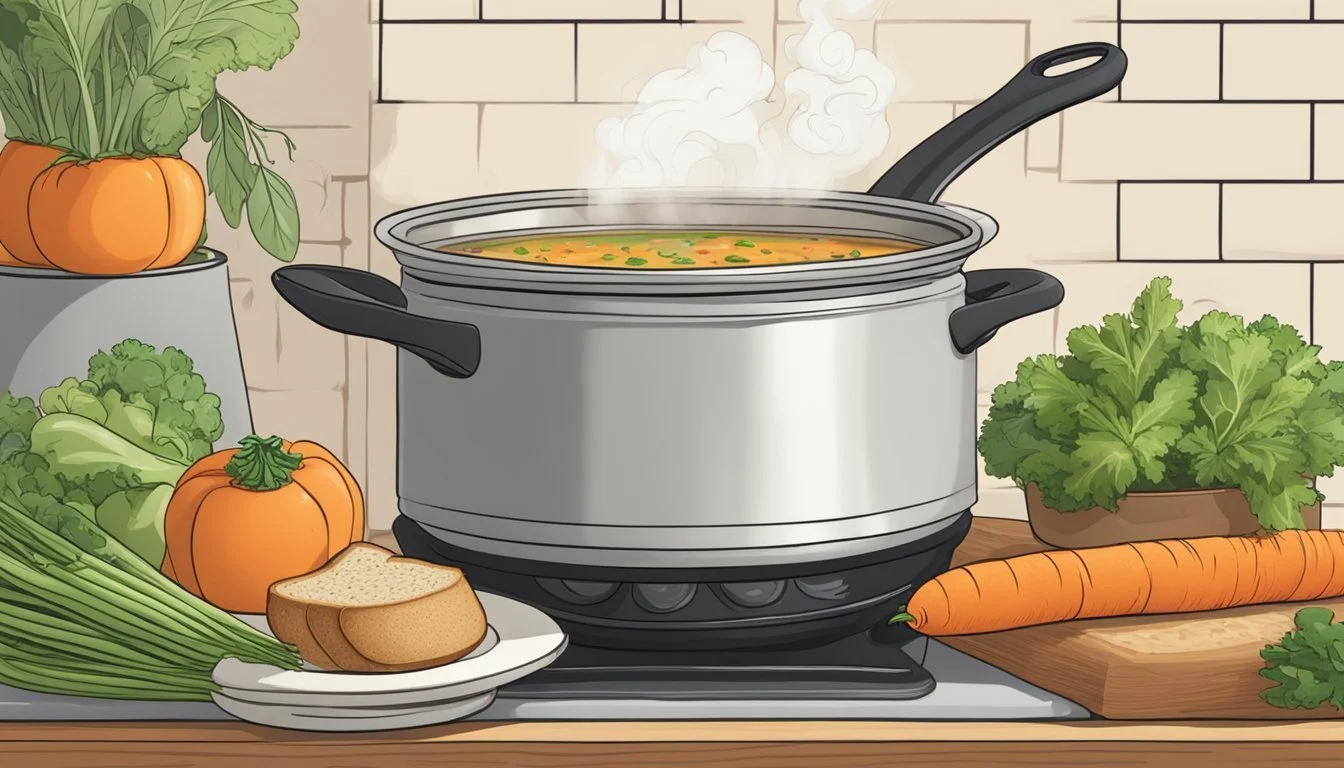How to Cook When You're Sad and Need Comfort
Simple Recipes for Uplifting Your Mood
Cooking can be a therapeutic process, offering solace in the simple act of preparing a meal. For those experiencing moments of sadness or grappling with depression and anxiety, the kitchen becomes a haven where comfort food serves not just as sustenance, but as a tool for emotional healing. Comfort food is aptly named for its ability to provide solace, with its warmth, familiarity, and satisfying richness often evoking fond memories and a sense of well-being.
In times of emotional distress, the mental health benefits of cooking are manifold. The structured nature of following a recipe can offer a sense of control and focus, helping to anchor an individual in the present moment and alleviate feelings of anxiety. Moreover, the aromas, textures, and flavors involved in the cooking process can act as sensory distractions, providing a respite from persistent negative thoughts.
When motivation is low, simplicity in cooking is key. It's essential to choose recipes that require minimal effort yet yield maximum comfort. Dishes that use easily available ingredients or promote creativity without the need for elaborate preparations can encourage one to engage in the cooking experience without feeling overwhelmed. Ultimately, it's about finding joy in the creation of a meal that not only feeds the body but also nurtures the soul.
Understanding Comfort Food
Comfort food often serves as a soothing presence during emotional lows. It provides both psychological solace and physiological satisfaction that can momentarily alleviate feelings of sadness.
Psychological Effects
Comfort foods are typically associated with positive memories and emotions. When individuals consume foods such as chocolate or pasta, which are often laden with sugar and carbohydrates, they may experience a temporary mood boost. This is because these foods can trigger the release of neurotransmitters like serotonin, contributing to feelings of well-being and happiness.
Symptoms of Depression: While comfort foods can offer temporary relief from symptoms of depression like sadness or hopelessness, they are not a cure for depressive symptoms. The pleasure derived from comfort foods can act as a form of self-medication, providing a short-term uplift in mood.
Choosing Your Comfort Foods
When selecting comfort foods, people often gravitate towards items such as cheese, bread, and pasta. These foods are typically high in fats and carbohydrates that can lead to a temporary feeling of fullness and satisfaction.
Cheese: Rich in fats, cheese is craved for its creamy texture and comforting taste.
Bread: A staple comfort food, bread offers a quick source of carbohydrates.
Pasta: Seen as a heartier comfort food, pasta combines carbohydrates with numerous options for rich, flavorful sauces.
One should choose comfort foods mindfully, considering both their emotional state and nutritional needs. While these foods may provide temporary emotional relief, reliance on them as a primary coping mechanism for depressive symptoms is not advisable.
Nutritional Considerations When Sad
When one experiences sadness, maintaining a diet that supports both emotional and physical well-being is crucial. The focus should be on balancing macronutrients, ensuring adequate intake of micronutrients, and staying hydrated.
Balancing Macronutrients
One must ensure their meals contain a balance of proteins, fats, and carbohydrates. Proteins are essential for neurotransmitter function, which affects mood. Sources like chicken, fish, tofu, and legumes are excellent options. Fats, particularly omega-3 fatty acids found in fish and flaxseeds, play a role in brain health. Carbohydrates are fuel for the body and, when chosen wisely, can also aid in the production of serotonin, a mood regulator. Opt for complex carbohydrates such as whole grains and legumes.
The Role of Micronutrients
Micronutrients, while needed in smaller quantities, have significant impacts on mood and well-being. Magnesium, found in dark leafy greens, nuts, and seeds, can help manage stress. Iron, which is vital for energy levels, can be sourced from meats and fortified cereals, though pairing it with vitamin C-rich foods aids absorption. Antioxidants combat oxidative stress and can be found in fruits, vegetables, and whole grains.
Hydration and Mood
Hydration is often overlooked in discussions about mood and food, but it can have a profound effect. Dehydration may contribute to lethargy and mood disturbances. They should aim to drink water throughout the day, as it can help manage mood swings and improve concentration.
Easy Meal Preparation
Cooking can be a restorative activity, and when individuals are feeling down, they often benefit from preparing easy meals that offer comfort without requiring much effort.
Quick and Simple Recipes
One can resort to recipes that minimize time and effort. A reliable option is Breakfast Kimchi Fried Rice, which utilizes leftover rice and simple ingredients like kimchi and egg. They can also prepare meals involving roasted vegetables and proteins. For example, drizzling olive oil over a tray of vegetables and chicken thighs and baking them is not only straightforward but also nutritious and satisfying.
Ingredients:
Leftover rice
Kimchi
1 egg
Olive oil
Vegetables (e.g. carrots, broccoli)
Chicken thighs
Directions:
Reheat rice and mix with chopped kimchi and a fried egg.
Toss vegetables with olive oil, salt, and pepper; spread on a baking sheet.
Place chicken thighs skin-side up on top; season heavily.
Bake until vegetables are tender and chicken is cooked through.
Using Leftovers and Staples
Individuals can create comforting meals by utilizing leftovers and pantry staples. Using pre-cooked rice (how long does cooked rice last?) or frozen rice cuts down on preparation time and ensures there is always a base ready for a quick meal. Adding a dollop of butter can elevate the taste. For a more complete meal, one can combine rice with frozen vegetables or canned beans for added protein and fiber.
Suggested Combinations:
Pre-cooked rice with frozen peas and canned tuna (What wine goes well with tuna?)
Leftover vegetables and shredded cheese for an impromptu casserole
Buttered rice with a sprinkle of cheese and black pepper
Cooking with a Slow Cooker
A slow cooker can be a valuable ally for those wanting to prepare meals with minimal effort. Individuals can easily make soups, stews (What wine goes well with stews?), or casseroles (What wine goes well with casseroles?) by adding ingredients like frozen meat, veggies, and a liquid base (such as broth or canned tomatoes) into the slow cooker and letting it do the work. This method not only saves time but allows flavors to meld together, creating a comforting meal to enjoy after hours of low-effort cooking.
Slow Cooker Ideas:
Chicken and rice casserole with cream of mushroom soup
Beef stew (What wine goes well with beef stew?) with root vegetables and broth
Vegetarian chili (What wine goes well with vegetarian chili?) with canned beans, tomatoes, and frozen corn
By utilizing quick recipes, leftovers, staples, and a slow cooker, one can prepare easy and comforting meals even when their mood is low. These methods ensure that meal preparation is not a daunting task, but a manageable and even comforting process.
Mood-Boosting Foods
Certain ingredients can have a positive effect on mood, providing comfort and potentially alleviating symptoms of depression. Additionally, some foods can improve sleep quality, which is critical for emotional well-being.
Ingredients That Help Fight Depression
Specific nutrients and foods are recognized for their potential to help fight depression:
Omega-3s: These fatty acids, found in fatty fish like salmon, are associated with brain health and may help improve mood.
Walnuts & Chia Seeds: Both are plant-based sources of omega-3s and can be incorporated into one's diet to boost brain function.
Berries: These fruits are high in antioxidants and can help reduce inflammation, which is linked to depression.
Dark Chocolate: Contains flavonoids, caffeine, and theobromine, which are thought to work together to improve mood.
Foods That Improve Sleep
Getting a good night's sleep is essential for mental health. Some foods can promote better sleep:
Fatty Fish: The vitamin D and omega-3 fatty acids in fatty fish have been linked to enhanced sleep quality due to the production of serotonin.
Walnuts: They contain melatonin and healthy fats, both of which may support improved sleep.
Chia Seeds: They have tryptophan, an amino acid that can help the body produce serotonin and melatonin, aiding in better sleep cycles.
Soothing Soups and Stews
In times of sadness, comfort can often be found in the warmth of a well-made soup or stew. These dishes not only nourish the body but also provide a sense of solace and warmth.
Comforting Ingredients
Key ingredients in comforting soups and stews include broth, noodles, veggies, and chicken. A rich chicken broth serves as an excellent base, contributing both flavor and nutrients. Adding noodles brings a satisfying texture that complements the liquid component.
Soothing Ingredients Role in Soup/Stew Chicken broth Base; enhances flavor Noodles Adds texture; comfort food Veggies Provides nutrients; texture Chicken nuggets Protein source; satisfying bites Frozen spinach Easy nutrition boost; earthy flavor Miso soup Balancing umami flavor; soothing broth
One might incorporate chicken nuggets or pieces, fried for a satisfying crunch and then simmered for infusion into the broth. Frozen spinach is convenient for a quick addition of color and nutrients, wilting seamlessly into the soup. For a more comforting umami touch, one could whisk miso paste into the broth, creating a soothing miso soup.
Preparation Techniques
Preparation techniques play a crucial role in crafting comforting soups and stews. It begins with a gentle simmering of the broth, allowing flavors to meld harmoniously. Incorporating ingredients such as veggies and noodles should be timed carefully—noodles must be cooked just until tender, and veggies should retain some of their crispness to ensure a texturally pleasing experience.
Steps for Preparation Technique Details Simmering broth Flavor infusion; slow cook Cooking noodles Till tender; not overcooked Incorporating veggies Add towards end; retain crispness Adding chicken Simmer for flavor absorption
To achieve the best texture and flavor, the chicken, whether in the form of nuggets or other cuts, should be browned before being added to the soup. This browning locks in flavors and adds a depth that raw meat cannot provide. The slow and low cooking process is essential to evoke the fullness of flavors, especially when one seeks to envelop themself in the comfort of food.
Salads and Vegetables for Emotional Well-being
Preparing and consuming salads and vegetables can be a nurturing process that offers both nutritional benefits and emotional comfort. They provide essential vitamins and minerals that can influence mood and overall health.
Salad Variations
When creating a salad for emotional well-being, one should focus on incorporating a variety of greens like spinach and kale, which are rich in folate. Folate contributes to the production of neurotransmitters such as serotonin, which may improve mood. Here are some specific salad options:
Spinach Salad: Toss fresh spinach leaves with sliced strawberries, nuts, and a balsamic vinaigrette for a refreshing and mood-boosting dish.
Kale and Quinoa Salad: Mix chopped kale with cooked quinoa (how long does cooked quinoa last?), diced sweet potatoes, and a lemon-tahini dressing for a heartier option filled with fiber and nutrients.
Cooking Vegetables
Cooking vegetables can be a therapeutic activity, and the act of eating them can offer comfort. Cooking either fresh or frozen vegetables is beneficial, as both retain their nutritional value. Consider these methods:
Steaming: Steam a mix of your favorite vegetables like broccoli or carrots to retain maximum nutrients and natural flavors.
Roasting: Roasting vegetables such as sweet potatoes can caramelize their natural sugars, providing a satisfying, comfort-food experience.
Hearty and Filling Meal Ideas
When seeking solace in food during sad times, dishes that are both comforting and satisfying can be truly restorative. They focus on being rich in flavor and typically contain a higher protein content, providing a sense of fullness and nourishment.
International Comfort Foods
Globally, comfort foods share the common thread of warmth and rich flavors. Italian lasagna, layered with creamy ricotta, robust marinara sauce, and plenty of melted cheese offers a hug in a dish. Equally hearty is spaghetti, especially when twirled with a hearty meat sauce and sprinkled with parmesan. For an Asian twist, one might consider a comforting bowl of Japanese ramen with a savory broth, or perhaps a Korean bibimbap, a dish of rice with seasoned vegetables, spicy gochujang, and a fried egg on top.
Protein-Rich Dishes
Protein plays a crucial role in comfort foods, giving them a heartiness that satisfies.
Macaroni and cheese becomes a protein-packed meal with the addition of tuna or chunks of grilled chicken.
Traditional tuna casserole, with its creamy sauce, peas, and a crunchy breadcrumb topping, is simple yet fulfilling.
Another protein-rich option is baked salmon, which can deliver comfort especially when glazed with a sweet and tangy sauce. Whether flaked into pasta or served as a standalone dish, salmon provides essential omega-3 fatty acids, making it a nutritious choice for a comforting dinner.
Healthy Snacks for Tough Moments
When emotions run high, quick and nourishing snacks can provide comfort without the added stress of elaborate cooking. Focusing on snacks that can be both comforting and healthy is key.
Sweet and Savory Options
Sweet Options:
Fruit and Nut Butter: Slices of apple or banana paired with almond or peanut butter for a hit of healthy fats and protein.
Berry and Cream Cheese Crispbread: A crispbread topped with light cream cheese and antioxidant-rich blackberries, garnished with mint for freshness.
Savory Options:
Hummus and Veggie Sticks: A combination of hummus with celery, carrot, or cucumber sticks, offering a satisfying crunch.
Chips and Salsa: Baked whole grain chips with fresh tomato salsa serve as a fiber-filled snack.
Making Snacks Ahead of Time
Energy Bars:
Homemade Oat Bars: Bars made from rolled oats, chopped nuts, honey, and chocolate chips, baked ahead of time for a quick energy boost.
Pre-prepared Snacks:
Nuts and Seeds: A mix of almonds, walnuts, pumpkin seeds, and sunflower seeds, portioned into small bags.
Boiled Eggs: Boiled eggs refrigerated for up to a week, easy to peel and eat when needed for a protein-rich snack.
Embracing a Cooking Routine
When individuals are feeling down, a structured cooking routine can offer solace and a sense of normalcy. The very act of cooking serves as both a nourishing and therapeutic exercise, capable of elevating mental health.
Planning and Scheduling Meals
Planning ahead is a critical step in maintaining a routine that supports both nourishment and emotional well-being. Individuals may find it beneficial to schedule their meals for the week, which can include a mix of nutritious and comforting dishes.
Monday: Creamy Cauliflower Soup
Tuesday: Chicken Noodle Casserole
Wednesday: Pasta with Vegetables
Thursday: Hearty Bean Stew
Friday: Baked Fish with Roasted Potatoes
Saturday: Comforting Rice and Beans
Sunday: Vegetable Stir-Fry (What Wine Pairs Perfectly With Vegetable Stir-Fry?) with Tofu
A planned schedule helps alleviate the burden of deciding what to cook, especially on days when one's spirits are low. It ensures that they have all the necessary ingredients on hand, reducing stress and making the cooking process more enjoyable.
The Connection Between Cooking and Mental Health
Cooking can act as an informal form of therapy, providing a creative outlet and a sense of accomplishment. The rhythmic nature of chopping, stirring, and sautéing can be meditative and help individuals focus on the task at hand rather than their sorrows.
It’s important to acknowledge that cooking may not always feel feasible on particularly difficult days. In such moments, one might rely on meals prepped on better days or opt for simple yet nourishing meal ideas that don't require extensive effort. The key is consistency in nourishing the body, which in turn supports mental health.
Conclusion
Cooking during times of low mood can be both a challenge and an opportunity for self-care. Nutrient-rich dairy products and eggs are versatile ingredients that can provide comfort and nourishment. They are also ingredients typically associated with breakfast, a meal that offers a fresh start to one's day.
For those days when energy is lacking, simple, quick-to-prepare dishes can make all the difference. An omelet, for example, can be a quick source of protein. Incorporating dairy such as cheese can enhance both the flavor and the dish's comforting qualities.
Fresh ingredients are always the ideal choice for cooking, as they promise the full spectrum of taste and nutrients. However, stockpiling on fresh goods may not always be feasible. Therefore, using a mix of fresh and frozen ingredients can ensure that one can still prepare meals that are comforting and healthy.
On days when cooking feels like an insurmountable task, opting for takeout from a favorite restaurant can be a temporary yet immediate source of comfort. This choice is okay and can be integrated into one’s self-care routine, remembering that balance is key.
The aim is to make food an ally in one's emotional well-being:
Choose foods that boost one's mood: Incorporate ingredients rich in vitamins, minerals, and a comfort element.
Keep it simple: Focus on recipes that are easy to prepare and do not require long cooking times or complex techniques.
Embrace convenience when needed: Utilize pre-prepped ingredients or takeout strategically to relieve cooking stress.
Permit variety: Alternating between cooking and ordering food can provide a necessary respite and prevent burnout.
One must remember that being kind to oneself is paramount, and how one chooses to feed oneself during these times is part of that kindness.











